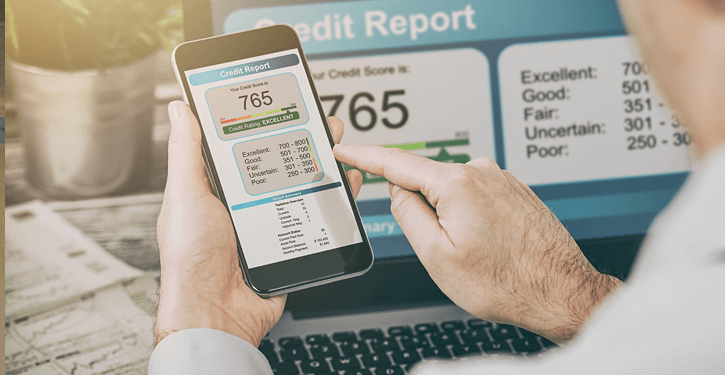What You Don’t Know Could Hurt You
You’re a champ at making your credit card payments on time. But checking your credit on the regular? That’s an entirely different story. It far too easy to forget to monitor your credit, but it could be dangerous to do so. You don’t want something damaging to sneak up on you.
Here are four reasons to monitor your credit, and ways to use Credit Sesame’s free credit monitoring tools and resources to help you do so:
1. Financial Infidelity

Financial infidelity is when a trusted loved one, usually a significant other, keeps a money secret, like undisclosed accounts or secret spending.
Financial infidelity can inflict serious damage to your credit. For instance, if someone secretly adds you as an authorized user on their credit card, it could show up on your credit file and affect your score. While you’re not legally responsible for paying off any outstanding debt as an authorized user, if the primary account holder runs a high balance or misses payments your credit score will probably suffer.
If you’re a Credit Sesame member, you can monitor your open accounts on your personalized dashboard, which reflects the data in your TransUnion credit report. Click “My Credit” under the “My Finances” tab on the top toolbar to look for changes in the following sections:
Account Mix. A telltale sign that someone has added you as an unauthorized user without your consent is that the number of open credit card accounts is greater than what it should be.
Credit Usage. Check for any changes in your credit card debt or total credit card limit that don’t add up.
Credit Age. See if your age of credit history has gone down although you haven’t added any new cards.
If anything looks awry, get to the bottom of it. These red flags could indicate a credit reporting error that needs to be corrected, or that someone is abusing your credit.
2. Identity Theft

Identity theft is when an imposter steals your personal info, such as a Social Security, driver’s license number, date of birth, or financial information for financial gain. A scary statistic: A recent Javelin study revealed that in 2015 13.1 million consumers in the U.S. lost about $15 billion dollars from identity theft.
If you’re a Credit Sesame member, you receive free identify theft protection and are covered up to $50,000. Plus, you’ll receive notifications and alerts of any suspicious activity.
If you have reason to believe you’ve been a victim of identity theft, act swiftly. Under the “ID Protection” tab at the top of your dashboard, you can access resources such as the Theft and Fraud Guide, letter templates, and phone numbers. Our specialists are also available to provide assistance. You can find more info under the “ID Protection” tab at the top of your dashboard.
3. Errors on Your Report

If you’ve been working to fix your credit and improve your credit score, you undoubtedly want your credit report to reflect that. Mistakes on your report do happen.
Common errors on your credit report can include:
- Address or phone number you never had
- Misspelled name or wrong middle initial
- Accounts that belong to someone with a name that’s similar to yours, or with a social security number that is similar to yours
- The same debt listed multiple times
- Incorrect dates
- Accounts that are mistakenly reported as late or delinquent
- Incorrect current balance
- Incorrect credit limit
- Closed accounts that are reported as open
- Accounts that appear multiple times with different creditors listed
- You’re reported as the primary owner of an account, when you’re actually just an authorized user
Review your report from each credit bureau at least annually. You can free order a report once a year from each of the three major credit reporting agencies (TransUnion, Experian, and Equifax) by visiting AnnualCreditReport.com. You can stagger them throughout the year or order them together. You should also monitor your credit regularly through Credit Sesame to ensure no errors sneak up between annual reviews. When the time comes to apply for credit, you want to know that your reports are exactly as they should be.
Although you may not be the cause of a credit report error, you are the responsible party when it comes to getting it fixed. Contact each credit reporting agency reporting the error to file a dispute.
4. Progress checks

Checking in to see just exactly how much headway you’ve made on credit improvement can boost your motivation. If you’re doing everything right, you should see steady progress.
If, on the other hand, you don’t see steady progress, you may need to review your Credit Sesame dashboard to find out what’s holding your score down and what steps you need to take to address it. Don’t be hard on yourself if you don’t fully understand how the many different credit score factors affect your score. We’re here to help you learn.
Credit Sesame assigns letter grades on your free credit report to each of the major factors that affect your score. If you’ve got an A for Payment History but a D for Credit Usage, you know that you’re doing great paying your bills but need to pay down your debt. Likewise, if your Credit Age is C, you should avoid applying for new accounts and leave your existing accounts open to age.
Here are some things you can keep an eye on using Credit Sesame’s personalized tools:
Your current debt: If you take a look under the “My Debt” tab, you’ll not only be able to see your total debt, but also how much your debt has changed from the previous month. You can see what your monthly debt load is for the current year, and a breakdown of your different types of debts: credit cards, home loans, auto loans, and student loans, and other loans, such as personal loans.
Borrowing power: The higher your credit score, the better the offers you’ll rake in. Credit Sesame employs a proprietary algorithm to analyze your credit health and recommend top offers based on your most favorable approval odds. The fun part is seeing how much credit you may be able to unlock when it comes time to borrow for a home or other large goal.
Monitoring your credit does take some of your time and attention, but you’ll be glad you made the effort.





















